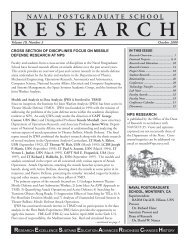Spectral Unmixing Applied to Desert Soils for the - Naval ...
Spectral Unmixing Applied to Desert Soils for the - Naval ...
Spectral Unmixing Applied to Desert Soils for the - Naval ...
Create successful ePaper yourself
Turn your PDF publications into a flip-book with our unique Google optimized e-Paper software.
B. ASD SPECTROMETER MEASURED ENDMEMBERS<br />
ASD collected endmembers yielded some interesting results. They were, <strong>to</strong> an<br />
extent, able <strong>to</strong> identify features, however <strong>the</strong> method required significant human<br />
interference, unlike using imagery derived endmembers. User supplied endmembers also<br />
rarely turned out MF scores greater than 50% and in many cases <strong>the</strong>y could only achieve<br />
30%. Likely this is <strong>the</strong> result of <strong>the</strong> endmembers used being ei<strong>the</strong>r <strong>to</strong>o dissimilar <strong>to</strong><br />
materials in <strong>the</strong> imagery, or not being spectrally unique enough <strong>to</strong> be detected in large<br />
quantity. In this particular study <strong>the</strong> results were still useful because <strong>the</strong> size of <strong>the</strong><br />
features (trails in particular) being identified would generally only occupy a pixel<br />
percentage between approximately 20 and 60% in conditions where <strong>the</strong> feature is<br />
unoccluded by o<strong>the</strong>r objects in <strong>the</strong> imagery.<br />
1. Camp Road Endmember<br />
User supplied endmembers from <strong>the</strong> clay collect, and <strong>the</strong> Mono/Owens valley<br />
areas were processed using <strong>the</strong> MTMF method first on <strong>the</strong> f110512t01p00r07 image<br />
subset <strong>the</strong>n on <strong>the</strong> f110512t01p00r08 flight log subset. Figure 30 shows one of <strong>the</strong><br />
endmember infeasibility images along with <strong>the</strong> resulting analysis using <strong>the</strong> scatterplot of<br />
infeasibility verses MF score. In this case, <strong>the</strong> endmember used is <strong>the</strong> spectrum of a<br />
moderate use dirt road leading in<strong>to</strong> a camp at <strong>the</strong> Mazourka Canyon site that has been<br />
input in<strong>to</strong> <strong>the</strong> f110512t01p00r07 flight log data. Infeasibility images show <strong>the</strong> highest<br />
value pixels, and <strong>the</strong>re<strong>for</strong>e <strong>the</strong> least feasible mixture of <strong>the</strong> target and background, as <strong>the</strong><br />
brightest. There are a few dirt roads visible in <strong>the</strong> true color imagery that appear in <strong>the</strong><br />
infeasibility image with scores of 5–10. These scores are close enough <strong>to</strong> zero (zero<br />
being a perfect match) <strong>to</strong> confirm <strong>the</strong> target material, especially since <strong>the</strong> brightest<br />
materials have scores of 30–100 (not feasible mixtures of background and target<br />
material). Using this in<strong>for</strong>mation with a scatterplot analysis, only sections with very low<br />
infeasibility (around 0–6) scores and an MF score of 10–25 were selected (Figure 30,<br />
inset A). The result was very few pixels being highlighted, and those that were had an<br />
MF of .11 or 11%.<br />
61
















